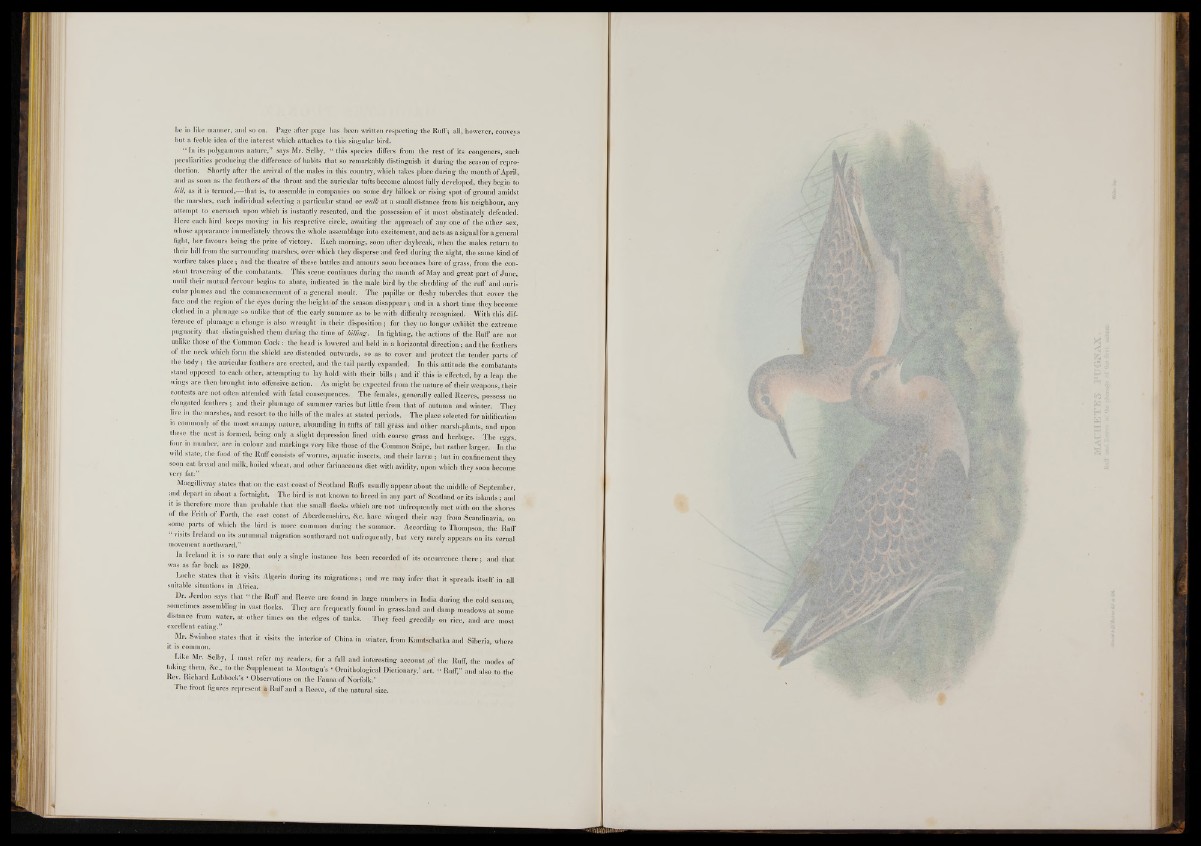
be in like manner, and so on. Page after page has been written respecting the Ruff; all, however, conveys
but a feeble idea of the interest which attaches to this singular bird.
“ In its polygamous nature,” says Mr. Selby, “ this species differs from the rest o f its congeners, such
peculiarities producing the difference o f habits that so remarkably distinguish it during the season of reproduction.
Shortly after the arrival o f the males in this country, which takes place during the month o f April,
and as soon as the feathers of the throat and the auricular tufts become almost fully developed, they begin to
hill, as it is termed,—that is, to assemble in companies on some dry hillock or rising spot o f ground amidst
the marshes, each individual selecting a particular stand or walk a t a small distance from his neighbour, any
attempt to encroach upon which is instantly resented, and the possession of it most obstinately defended.
Here each bird keeps moving in his respective circle, awaiting the approach o f any one o f the other sex,
whose appearance immediately throws the whole assemblage into excitement, and acts as a signal for a general
fight, her favours being the prize of victory. Each morning, soon after daybreak, when the males return to
their hill from the surrounding marshes, over which they disperse and feed during the night, the same kind of
warfare takes plac e; and the theatre of these battles and amours soon becomes bare of grass, from the constant
traversing of the combatants. This scene continues during the month of May and great part o f June,
until their mutual fervour begins to abate, indicated in the male bird by the shedding of the ruff and auricular
plumes and the commencement o f a general moult. The papillae o r fleshy tubercles that cover the
face and the region of the eyes during the height o f the season disappear; and in a short time they become
clothed in a plumage so unlike that o f the early summer as to be with difficulty recognized. With this difference
o f plumage a change is also wrought in their disposition; for they no longer exhibit the extreme
pugnacity that distinguished them during the time o f hilling. In fighting, the actions of the Ruff are not
unlike those o f the Common Cock: the head is lowered and held in a horizontal direction; and the feathers
o f the neck which form the shield are distended outwards, so as to cover and protect the tender parts of
the body; the auricular feathers are erected, and the tail partly expanded. In this attitude the combatants
stand opposed to each other, attempting to lay hold with their bills ; and if this is effected, by a leap the
wings are then brought into offensive action. As might be expected from the nature o f their weapons, their
contests are not often attended with fatal consequences. The females, generally called Reeves, possess no
elongated feathers ; and their plumage of summer varies but little from that of autumn and winter. They
live in the marshes, and resort to the hills o f the males at stated periods. The place selected for nidification
is commonly of the most swampy nature, abounding in tufts o f tall grass and other marsh-plants, and upon
these the nest is formed, being only a.slight depression lined with coarse grass and herbage. The eggs,
four m number,' are in colour and markings very like those of the Common Snipe, but rather larger. In the
wild state, the food of the Ruff consists o f worms, aquatic insects, and their l am e ; but in confinement they
soon eat bread and milk, boiled wheat, and other farinaceous diet with avidity, upon which they soon become
very fat:”
Macgillivray states that on the east coast o f Scotland Ruffs usually appear abdut the middle o f September,
and depart in about a fortnight. The bird is n o t known to breed in any part o f Scotland or its islands; and
it is therefore more than probable that the small docks which are not unfreqiiently met with on the shores
of the F rith of Forth, the east coast of Aberdeenshire, &c. have winged their way from Scandinavia, <jn
some parts of which the bird is more common during the summer. According to Thompson, the Ruff
“ visits Ireland on its autumnal migration southward not (infrequently, but very rarely appears on its vernal
movement northward.” ! ,
In Iceland it is so rare that only a single instance has been recorded o f its occurrence th e r e : and that
was as far back as 1820.
Loche states that it visits Algeria during its migrations; and we may infer that it spreads itself in all
suitable situations in Africa.
Dr. Jerdon says that “ the Ruff and Reeve are found in large numbers in India during the cold season,
sometimes assembling in vast ffocks. They are frequently found in grass-land. and damp meadows a t some
distance from water, at other times on the edges o f tanks. They feed greedily on rice,i and are most
excellent eating.”
Mr. Swmhoe states that it-visits the interior o f China in winter, from Kamtschatka and Siberia, where
it is common.
Like Mr. Selby, I must refer my readers, for a full and interesting'-account.of Alie Ruff, the modes of
taking them, See., to the Supplement to Montagu’s ‘ Ornithological Dictionary,’ art. “ Ruff,” and also to the
Rev. Richard Lubbock’s ‘ Observations on the Fauna o f Norfolk.’
Tne front figures rep re sen t^ Ruff aud a Reeve, of the natural size.